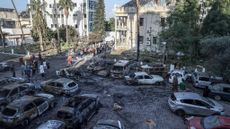North Korea and the limits of missile diplomacy
After ‘duelling’ missile tests on the Korean peninsula, North Korea’s intentions are harder than ever to read

The Korean peninsula was the site of “duelling” missile tests last week, said Michael Lee in Korea JoongAng Daily (Seoul). On Wednesday, North Korea launched two tactical ballistic missiles, from a train, in defiance of UN resolutions. South Korea, for its part, conducted a submarine-launched ballistic missile test, becoming the first nation without nuclear weapons to have that capability. The tests came soon after North Korean state media said that a long-range cruise missile capable of hitting Japan had been fired into the sea 930 miles away. Cruise missiles can carry a nuclear warhead, and are of particular concern because they fly low and can change direction in flight, evading defence systems.
This arms race had been widely anticipated, said Jung Da-min in Korea Times (Seoul). Donald Trump’s attempt to make a grand bargain with Kim Jong Un failed; President Biden’s efforts to bring him to the negotiating table have been ineffective. In the summer, Pyongyang restarted its plutonium-producing reactor at Yongbyon. In response, South Korean president Moon Jae-in’s policy has been to strengthen his nation’s missile capabilities. Submarine-launched missiles, of the kind his forces have developed, are vital to maintaining a “retaliatory strike” capability: a country that has them can hit back hard, even if its military installations have been devastated by a nuclear attack. The pace has picked up since Biden met Moon at a summit in May and agreed to scrap restrictions on South Korea’s missile programme.
North Korea’s intentions are now harder than ever to read, said Michelle Ye Hee Lee in The Washington Post. Pyongyang sealed its borders during the pandemic, excluding even its only major trading partner, China. This prompted an exodus of foreigners – diplomats, aid workers, business envoys – who usually provided some insights into life in the totalitarian country. But the UN believes its people are suffering “severe” food shortages, and that there is a risk of a major famine. The reasons for its missile tests are still clear enough, said Christoph Bluth and Owen Greene on The Conversation. North Korea uses tests to demonstrate to its own population that “it is a great and powerful nation”. As far as the world outside is concerned, they are designed to “mitigate diplomatic isolation and as leverage to generate international aid”. There are, at present, no credible diplomatic initiatives for engaging with Pyongyang. So we can “expect further missile launches – and possibly nuclear weapons tests – in the near future”.
Subscribe to The Week
Escape your echo chamber. Get the facts behind the news, plus analysis from multiple perspectives.

Sign up for The Week's Free Newsletters
From our morning news briefing to a weekly Good News Newsletter, get the best of The Week delivered directly to your inbox.
From our morning news briefing to a weekly Good News Newsletter, get the best of The Week delivered directly to your inbox.
Sign up for Today's Best Articles in your inbox
A free daily email with the biggest news stories of the day – and the best features from TheWeek.com
Create an account with the same email registered to your subscription to unlock access.
-
 'Good riddance to the televised presidential debate'
'Good riddance to the televised presidential debate'Instant Opinion Opinion, comment and editorials of the day
By Harold Maass, The Week US Published
-
 Caitlin Clark the No. 1 pick in bullish WNBA Draft
Caitlin Clark the No. 1 pick in bullish WNBA DraftSpeed Read As expected, she went to the Indiana Fever
By Peter Weber, The Week US Published
-
 Today's political cartoons - April 16, 2024
Today's political cartoons - April 16, 2024Cartoons Tuesday's cartoons - sleepyhead, little people, and more
By The Week US Published
-
 Puffed rice and yoga: inside the collapsed tunnel where Indian workers await rescue
Puffed rice and yoga: inside the collapsed tunnel where Indian workers await rescueSpeed Read Workers trapped in collapsed tunnel are suffering from dysentery and anxiety over their rescue
By Sorcha Bradley, The Week UK Published
-
 Gaza hospital blast: What the video evidence shows about who's to blame
Gaza hospital blast: What the video evidence shows about who's to blameSpeed Read Nobody wants to take responsibility for the deadly explosion in the courtyard of Gaza's al-Ahli Hospital. Roll the tape.
By Peter Weber, The Week US Published
-
 Giraffe poo seized after woman wanted to use it to make a necklace
Giraffe poo seized after woman wanted to use it to make a necklaceTall Tales And other stories from the stranger side of life
By Chas Newkey-Burden, The Week UK Published
-
 Helicopter sound arouses crocodiles
Helicopter sound arouses crocodilesTall Tales And other stories from the stranger side of life
By Chas Newkey-Burden, The Week UK Published
-
 Woman sues Disney over 'injurious wedgie'
Woman sues Disney over 'injurious wedgie'Tall Tales And other stories from the stranger side of life
By Chas Newkey-Burden, The Week UK Published
-
 Emotional support alligator turned away from baseball stadium
Emotional support alligator turned away from baseball stadiumTall Tales And other stories from the stranger side of life
By Chas Newkey-Burden, The Week UK Published
-
 Europe's oldest shoes found in Spanish caves
Europe's oldest shoes found in Spanish cavesTall Tales And other stories from the stranger side of life
By Chas Newkey-Burden, The Week UK Published
-
 Artworks stolen by Nazis returned to heirs of cabaret performer
Artworks stolen by Nazis returned to heirs of cabaret performerIt wasn't all bad Good news stories from the past seven days
By The Week Staff Published